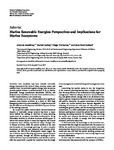Marine Renewable Energies: Perspectives and Implications for Marine Ecosystems
| dc.contributor.author | Azzellino, A | |
| dc.contributor.author | Conley, D | |
| dc.contributor.author | Vicinanza, D | |
| dc.contributor.author | Kofoed, JP | |
| dc.date.accessioned | 2020-09-21T16:55:33Z | |
| dc.date.available | 2020-09-21T16:55:33Z | |
| dc.date.issued | 2013 | |
| dc.identifier.issn | 1537-744X | |
| dc.identifier.issn | 1537-744X | |
| dc.identifier.other | ARTN 547563 | |
| dc.identifier.uri | http://hdl.handle.net/10026.1/16412 | |
| dc.description.abstract |
Countries with coastlines may have valuable renewable energy resources in the form of tides, currents, waves, and offshore wind.The potential to gather energy from the sea has recently gained interest in several nations [1–3], so Marine Renewable Energy Installations (hereinafter MREIs) will likely become very diffuse in the near future and determine a further transformation of our coastal seas. Coastal zones are, in fact, already subjected to significant pressure from human activities, as a result of their high biological productivity and accessibility. It might be expected that the MRE sector development will add its impacts to those of the existing pressures. Up to now the public concern about the environmental impacts of renewable energy projects has been a major factor behind the stalling or rejection of many planning applications for on-shore renewables developments. Siting renewables facilities in off-shore locations would appear to reduce this tension [4], but it cannot be forgotten that coastal ecosystems have already experienced major changes due to human activities, while the spatial conflicts of sea uses and demands are increasingly growing. In such a complex framework of existing uses, pressures, and foreseen developments, the MRE sector development makes urgent the use of Marine Spatial Planning approaches. Spatial decision support systems, through the efficient exchange of information between experts, stakeholders, and decision makers, offer the opportunity to guide the transition from the single sector management toward the integrated management of sea uses | |
| dc.format.extent | 1-3 | |
| dc.format.medium | Electronic-eCollection | |
| dc.language | en | |
| dc.language.iso | eng | |
| dc.publisher | Hindawi Limited | |
| dc.subject | Ecosystem | |
| dc.subject | Renewable Energy | |
| dc.subject | Seawater | |
| dc.title | Marine Renewable Energies: Perspectives and Implications for Marine Ecosystems | |
| dc.type | journal-article | |
| dc.type | Editorial Material | |
| plymouth.author-url | https://www.ncbi.nlm.nih.gov/pubmed/23956696 | |
| plymouth.volume | 2013 | |
| plymouth.publication-status | Published | |
| plymouth.journal | The Scientific World Journal | |
| dc.identifier.doi | 10.1155/2013/547563 | |
| plymouth.organisational-group | /Plymouth | |
| plymouth.organisational-group | /Plymouth/Faculty of Science and Engineering | |
| plymouth.organisational-group | /Plymouth/PRIMaRE Publications | |
| plymouth.organisational-group | /Plymouth/REF 2021 Researchers by UoA | |
| plymouth.organisational-group | /Plymouth/REF 2021 Researchers by UoA/UoA07 Earth Systems and Environmental Sciences | |
| plymouth.organisational-group | /Plymouth/Research Groups | |
| plymouth.organisational-group | /Plymouth/Research Groups/Marine Institute | |
| plymouth.organisational-group | /Plymouth/Users by role | |
| plymouth.organisational-group | /Plymouth/Users by role/Academics | |
| dc.publisher.place | United States | |
| dcterms.dateAccepted | 2013-01-01 | |
| dc.identifier.eissn | 1537-744X | |
| dc.rights.embargoperiod | Not known | |
| rioxxterms.versionofrecord | 10.1155/2013/547563 | |
| rioxxterms.licenseref.uri | http://www.rioxx.net/licenses/all-rights-reserved | |
| rioxxterms.licenseref.startdate | 2013 | |
| rioxxterms.type | Journal Article/Review | |
| plymouth.funder | Flow & Benthic Ecology 4D (FLOWBEC)::NERC |


